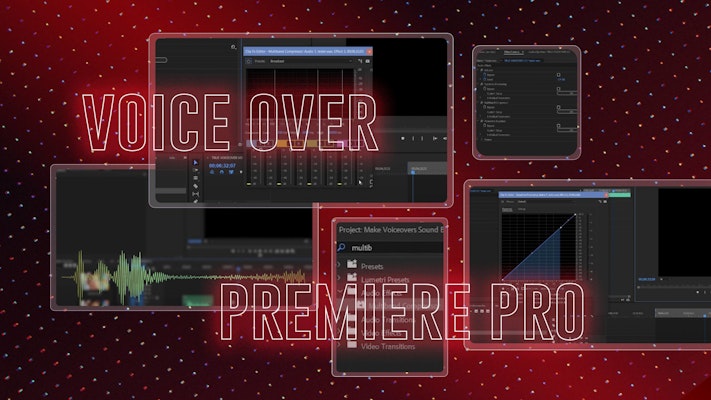If you’re doing any voice-over in Adobe Premiere Pro, you may be feeling overwhelmed by all of the settings. You want to make your audio sound as good as possible but might not know where to begin.
With a few tips and tricks, you can take a voice-over from sounding like you’ve recorded it as an afterthought, to sounding more full, rich, and professional. Let’s dive in!
Summary
Part 1: How to Record & Edit Voice-Overs in Adobe Premiere Pro
Before you start tweaking settings, you’ll need a decent recording to work with. It’s hard to try and make the audio sound more professional when there are problems like room echo and popping from certain annunciations. So before you record, try doing the following:
- Aim to record your audio so that it’s sitting around the -15db range on average. This will help to make sure that you don’t clip when recording and gives you some room to play around with editing.
- If you’re having trouble getting rid of room echo, give recording inside your closet a shot. The clothing there will act as a natural sound dampener.
- Record your audio with your mouth between 1 to 4 inches away from the microphone.
- Use a pop filter to avoid the harsh p and t sounds that come with proper enunciation.
Once you have your recording, take a listen to how it sounds raw. If you’ve followed the steps above, it should sound pretty good from the start!
Pro Tip: Loop Your Voice-Over Audio
Before you get on with your edits, it can help to isolate the piece of audio that you’re making adjustments to.
- To keep it on a loop, simply go to the beginning with your playhead, hit the I on your keyboard, then go to the endpoint of this audio, and hit the O key. This will set your In and Out points.
- Go up to your program monitor, click the + icon in the corner, and find the looping icon which is a triangle inside a square.
- Drag and drop that onto your Buttons tab. Now when you click it, you can make your audio loop between the In and Out points.
Step 1: Apply Dynamics Processing
Now you have your recording looping and set the sound type, your voice-over probably sounds a little flat. To achieve a more full and rich sound, you’ll need to apply some filters.
- Search in your Audio Effects panel for Dynamics Processing.
- Now in your Effects Controls panel, you should see that the effect is present. Click on edit to bring up your window and start to play around with this effect.
- Keep the default settings and take the point that’s above -20db and raise it slightly.
- Click to add a new point at around -60db and raise that as well.
- Keep playing your audio on a loop during this process. You can hear how you’re changing your audio, and whether or not it’s changing to your liking. Everyone’s voice is different, so play around with the settings until you find what works best for you!
Step 2: Add Multiband Compressor
- Search for the Multiband Compressor.
- Click Edit to open it up and simply select the first preset for broadcast.
- What you should immediately notice is that your voice should get much louder. To combat this, you can either decrease the Output gain or the overall volume of your clip.
- To make your voice sound more deep, bassy, and authoritative, increase the Threshold a bit in the low to mid-range. Then slightly increase the mid to high section on the slider to the right.
- Move this marker in the top display box to the left so that your boost to the mid to low section includes a little more of the deeper end.
Step 3: Add Parametric Equalizer
- Search for the Parametric Equalizer effect.
- Drag and drop it onto your audio and click the edit button to start working with it.
- Go to your presets section and choose Vocal Enhancer. This should get you pretty close to where you need to go on its own. By using the Frequency and Gain sliders as well, you can manipulate the curves so that, for example, you boost your bass a bit more, and have a smoother curve into our mid-range vocals.
With all that out of the way, take a listen to the before and after. The difference may be subtle, but it can help take your voice-overs or narration to the next level of quality.
Optional: Save Settings as a Preset
You can save all these settings as a preset to quickly use again on another project or audio recording.
- Highlight all three of these effects by holding Control or Command and clicking.
- Right-click on the highlighted area and click to Save the Preset.
- Name it whatever you want.
Now the next time you need to boost your voice-over, the whole process is a simple click and drag from your preset section.
Part 2: Using the Sound Panel to Enhance Voice in Premiere Pro
Step 1: Set the Sound Type
Once you have imported your voice-over file, let’s begin by setting the correct parameters as we edit the voice-over.
- Go to the Audio tab, and you will then see the Essential Audio panel.
- With your audio clip selected in your timeline, you will notice 4 sound-type options you can choose from. For voice-over, select the Dialogue.
Step 2: Enhance Your Voice
- Once you select the Dialogue option, you will notice a whole set of effects and parameters you can now apply to your audio file. We recommend keeping the Preset at Default.
- Select Auto Match under Loudness, which will set the loudness to a balanced level.
- Now under Clarity, you will notice the 3 main effects that you will need to enhance your voice in your audio clip.
- Select the Dynamics checkbox to turn it on. Use the slider to adjust it to your liking. The more you move it from Natural to Focus, the more it will level out your voice and make it sound better.
- Under the EQ > Presets, we recommend using one of the Subtle Boost or the Podcast Voice options. But you can also choose the Voice Presence option.
- Lastly, you can adjust the Enhance Speech. Depending on the voice you are working with, female or male, select either High Tone or Low Tone. Usually, for male voices, we recommend sticking with the low tones.
That’s it! Now you know how to use Adobe Premiere Pro to record your voice-over narration. You’ve got some tips to improve your recording space and enhance your audio in post-production. This should make a difference in your next video project that you can really hear!



























